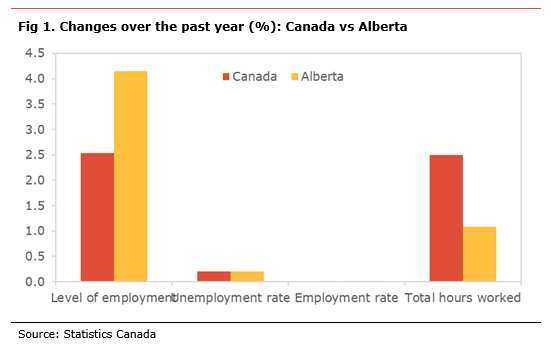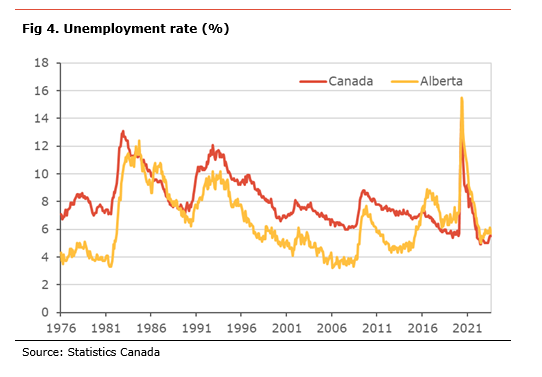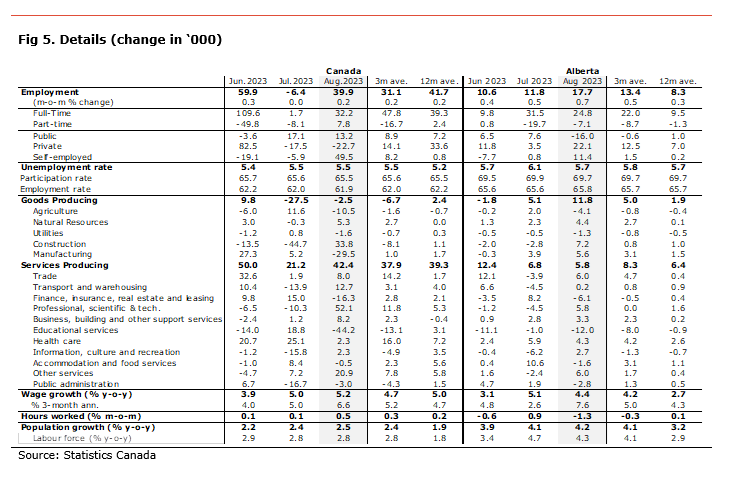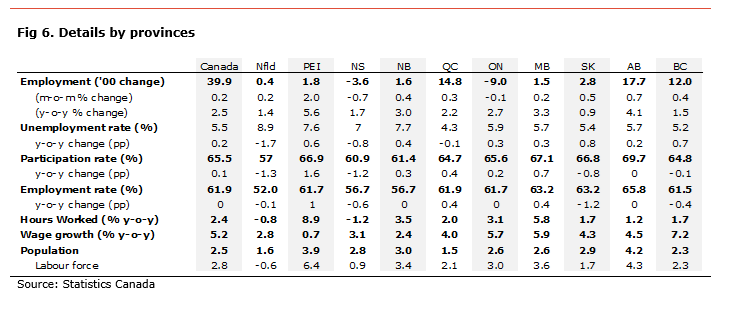Economic insight provided by Alberta Central Chief Economist Charles St-Arnaud. This report includes regional details for Alberta.
Bottom line
Today’s Labour Force Survey data points to a resilient labour market in Canada, with stronger than expected job gains and an unemployment rate of 5.5%. Moreover, the strong rise in hours worked suggests a rebound in economic activity in August.
The report also showed that wage growth rose to 5.2%. Moreover, we estimate that the 3-month annualized change of the seasonally-adjusted series jumped to 6.2%, suggesting further acceleration in wage growth in recent months. It is interesting to note that most of the acceleration in wage growth was in the service sector.
The Bank of Canada is likely to be slightly concerned by the continued strong wage gains, especially the disconnect to productivity growth, and the unchanged unemployment rate, as they both suggest the labour market remains very tight.
While little progress was made in August to create some slack in the labour market and that growth may be stronger, we do not believe it will change the BoC’s view of the economy meaningfully nor will it push the central bank to hike. The BoC has made it clear that the path for monetary policy depends on the outlook for inflation and whether we see some easing momentum in core measures of inflation.
We believe that the BoC will leave its policy rate unchanged for the rest of the year, as some time is needed for higher interest rates to fully impact the economy. As we have shown, monetary policy entered restrictive territory in late 2022 or early 2023, depending on the measure. Historical patterns suggest that a downturn usually follows 5 to 7 quarters later, suggesting very weak growth late this year and early next year. (see What happened to the recession? The role of the policy stance and demographic).
Alberta saw another robust increase in employment in August and a decline in the unemployment rate. Over the past twelve months, the Alberta labour market has outperformed the rest of the country in terms of job gains. However, the unemployment rate in Alberta remains higher than the national measure, partly due to the strong population growth. However, wage growth in Alberta (+4.5% y-o-y) continues to underperform the rest of the country (see Where’s the boom? And the rise and fall of the Alberta Advantage for some explanations).
Employment rose by 39.9k in August, stronger than expectations. Despite the strong gains in employment, the unemployment rate remained unchanged at 5.5%. The stable unemployment rate was mainly due to a small decline in the participation rate to 65.5% from 65.6%. The employment rate, the share of the population holding a job, decreased to 61.9%, as population growth was much stronger than employment gains. Statistics Canada estimates that employment needs to increase by roughly 50k per month to keep the employment rate steady.
Wage growth for permanent workers accelerated to 5.2% y-o-y. The 3-month annualized change in wages also increased to 6.6%, suggesting that wage growth is accelerating rapidly after some moderation.
The details show that the job gains in August were mainly full-time (+32.2k), while part-time jobs increased marginally (+7.8k). In addition, the higher employment was mostly in self-employed (+49.5k) and the public sector (+13.2k), while it was lower in the private sector (-22.7k).
On an industrial level, the employment gains were mostly in the service sector (+42.4k), while goods-producing sector saw a slight decline (-2.5k).
The details in the good-producing sector show that the job losses were mainly in manufacturing (-29.5k) and agriculture (-10.5k). This was partly offset by gains in construction (+33.8k) and natural resource extraction (+5.3k).
The gains in the service industry were concentrated in professional, scientific and technical services (+52.1k), other services (+20.9k), transport and warehousing (+12.7k) and trade (+8.0k). Losses in education services (-44.2k), and finance, insurance and real estate (-16.3k) partly offset these gains.
At a provincial level, the job gains were mainly seen in Alberta (+17.7k), Quebec (+14.8k) and BC (+12.0k). Employment declined in Ontario (-9.0k) and Nova Scotia (-3.6k). The unemployment rate edged higher in most provinces, except in Newfoundland (-1.8 percentage points (pp)), Nova Scotia (-1.2pp), and Quebec (-0.1pp). It increased the most in Saskatchewan (+0.8pp), BC (+0.7pp), and PEI (+0.6pp). The unemployment rate is the highest in Newfoundland (+8.9%), New Brunswick (+7.7), and PEI (7.6%). It is the lowest in Quebec (4.3%), BC (5.2%), and Saskatchewan (+5.4%).
Wages increase the most in BC (+7.2% y-o-y), Manitoba (+5.9% y-o-y), and Ontario (5.7% y-o-y) and the least in PEI (+0.7% y-o-y), New Brunswick (+2.4% y-o-y), and Newfoundland (+2.8% y-o-y).
In Alberta, employment increased by 17.7k in August. With the robust job gain and a decline in the participation rate to 69.7% from 69.9%, the unemployment rate eased to 5.7%. The employment rate, the share of the population holding a job, rose to 65.8%, suggesting that the employment gains were stronger than the increase in working-age population, absorbing all the newcomers.
The job gains in Alberta were mainly in the private sectors (+22.1k) and self-employed (+11.4k), while there were losses in the public sector (-16.0k). Both the goods-producing sector (+11.8k) and the service sector (+5.8k) saw higher employment.
The increase in the goods-producing industry was mainly in construction (+7.2k), manufacturing (+5.6k), and natural resources (+4.4k). These gains were partly offset by losses in agriculture (-4.1k) and utilities (-1.3k).
The higher employment in the service sector was mainly in trade (+6.0k), other services (+6.0k), professional, scientific and technical (+5.8k), and health care (+4.3k). Lower employment in education (-12.0k), finance, insurance and real estate (-6.1k), and public administration (-2.8k) offset some of these gains.
On a regional basis[1], the data is published on a three-month average basis (see table below). Over the past three months, the province gained 10.2k jobs each month on average. Almost all of the gains were in Calgary (+13.2k), while there were some declines in Edmonton (-4.4k), and Western Alberta (-3.1k).
The unemployment rate for the province was slightly at 6.8%. However, the performance was mixed at the regional level. The unemployment rate rose the most in Western Alberta (1.2pp), Red Deer (+1.0pp), and Wood Buffalo-Cold Lake (+0.8pp), while it declined in Calgary (-0.1pp) and Camrose-Drumheller (-0.1pp).
The unemployment rate is the highest in Red Deer (+6.7%), Western Alberta (+6.3%) and Lethbridge-Medicine Hat (+6.2%). It is the lowest in Camrose-Drumheller (3.7%), Calgary (6.0%), and Wood Buffalo-Cold Lake (6.0%)
The employment rate for Alberta eased to 65.9%. The employment rate eased the most in Western Alberta (-1.0pp), and Edmonton (-0.7pp). It increased in Red Deer (+0.7pp), Wood Buffalo-Cold Lake (+0.6pp), Lethbridge-Medicine Hat (+0.5pp), and Camrose-Drumheller (+0.5pp).
[1] All the numbers are expressed as three-month average of the non-seasonally adjusted number.







Independent Opinion
The views and opinions expressed in this publication are solely and independently those of the author and do not necessarily reflect the views and opinions of any organization or person in any way affiliated with the author including, without limitation, any current or past employers of the author. While reasonable effort was taken to ensure the information and analysis in this publication is accurate, it has been prepared solely for general informational purposes. There are no warranties or representations being provided with respect to the accuracy and completeness of the content in this publication. Nothing in this publication should be construed as providing professional advice on the matters discussed. The author does not assume any liability arising from any form of reliance on this publication.